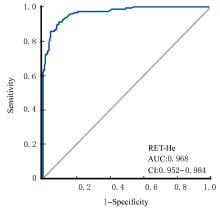| 1 |
叶玉琼. 网织红细胞血红蛋白含量在贫血患者中的表达及与血红蛋白的相关性分析[J]. 医学理论与实践, 2020, 33(6): 975-976.
|
| 2 |
蔡文娟, 张晓敏. 网织红细胞血红蛋白水平检测对缺铁性贫血鉴别诊断的意义[J]. 临床医学研究与实践, 2018, 3(16): 109-110.
|
| 3 |
崔煜烨. 网织红细胞血红蛋白含量测定在缺铁性贫血诊断中的价值[J]. 中国冶金工业医学杂志, 2020,37(6): 740-741.
|
| 4 |
杨占甲. 网织红细胞血红蛋白含量测定在缺铁性贫血诊断中的临床价值[J].青岛医药卫生,2019,51(2):81-84.
|
| 5 |
万学红, 卢雪峰. 诊断学[M]. 9版. 北京: 人民卫生出版社, 2018: 15-16.
|
| 6 |
陈 敏, 刘小伟. 网织红细胞参数诊断贫血性疾病的临床价值[J]. 医疗装备, 2021, 34(24): 28-29.
|
| 7 |
谢永华. 血常规检验在贫血鉴别诊断中的价值分析[J]. 中国现代药物应用, 2022, 16(18): 83-85.
|
| 8 |
OGAWA C, TSUCHIYA K, MAEDA K. Reticulocyte hemoglobin content[J]. Clin Chim Acta, 2020, 504: 138-145.
|
| 9 |
KEE Y K, JEON H J, OH J, et al. Hypochromic red cells as predictors of anemia in patients undergoing hemodialysis: an observational retrospective study[J]. Sci Rep, 2021, 11(1): 24215.
|
| 10 |
WOLLMANN M, GERZSON B M, SCHWERT V, et al. Reticulocyte maturity indices in iron deficiency anemia[J]. Rev Bras Hematol Hemoter, 2014,36(1): 25-28.
|
| 11 |
STOFFMAN N, BRUGNARA C, WOODS E R. An algorithm using reticulocyte hemoglobin content (CHr) measurement in screening adolescents for iron deficiency[J]. J Adolesc Health, 2005, 36(6): 529.
|
| 12 |
石 磊, 骆志成, 王 慧, 等. 血细胞多参数联合分析在大细胞性贫血疾病中的诊断价值[J]. 标记免疫分析与临床, 2017, 24(11): 1221-1224, 1228.
|
| 13 |
张文龙, 王曼萍, 张 骥, 等. 慢性病贫血的铁代谢研究[J]. 临床血液学杂志, 2008, 21(11): 588-589.
|
| 14 |
MAST A E, BLINDER M A, DIETZEN D J. Reticulocyte hemoglobin content[J]. Am J Hematol, 2008, 83(4): 307-310.
|
| 15 |
TORINO A B, GILBERTI M D E F, COSTA E D, et al. Evaluation of erythrocyte and reticulocyte parameters as indicative of iron deficiency in patients with anemia of chronic disease[J]. Rev Bras Hematol Hemoter, 2015, 37(2): 77-81.
|
| 16 |
HALLBERG L, BENGTSSON C, LAPIDUS L,et al. Screening for iron deficiency: an analysis based on bone-marrow examinations and serum ferritin determinations in a population sample of women[J]. Br J Haematol, 1993, 85(4): 787-798.
|
| 17 |
李 浩, 付美兰. 缺铁性贫血诊断的研究进展[J]. 医学综述, 2015, 21(3): 462-464.
|
| 18 |
THOMAS C, THOMAS L. Biochemical markers and hematologic indices in the diagnosis of functional iron deficiency[J]. Clin Chem, 2002, 48(7): 1066-1076.
|
| 19 |
PIVA E, BRUGNARA C, SPOLAORE F, et al. Clinical utility of reticulocyte parameters[J]. Clin Lab Med, 2015, 35(1): 133-163.
|
| 20 |
BÓ S D, FRAGOSO A L R, FARIAS M G, et al. Evaluation of RET-He values as an early indicator of iron deficiency anemia in pregnant women[J]. Hematol Transfus Cell Ther, 2023, 45(1): 52-57.
|
| 21 |
周 亮, 郭建晖, 张小蓬. 网织红细胞血红蛋白含量结合铁代谢参数在诊断成人缺铁性贫血中的临床价值[J]. 中国临床新医学, 2020, 13(7): 708-713.
|
| 22 |
袁秋蓉, 牛诗琼, 林雪萍, 等. RBC、Ret-He与HbA2联合检测对地中海贫血的临床价值[J]. 中国实验血液学杂志, 2021, 29(1): 203-206.
|
| 23 |
丁 捷. 促红细胞生成素、血清铁、网织红细胞平均血红蛋白含量联合检测在老年肾性贫血治疗中的应用价值观察[J]. 中国实用医药, 2021, 16(7): 88-89.
|
 )
)









